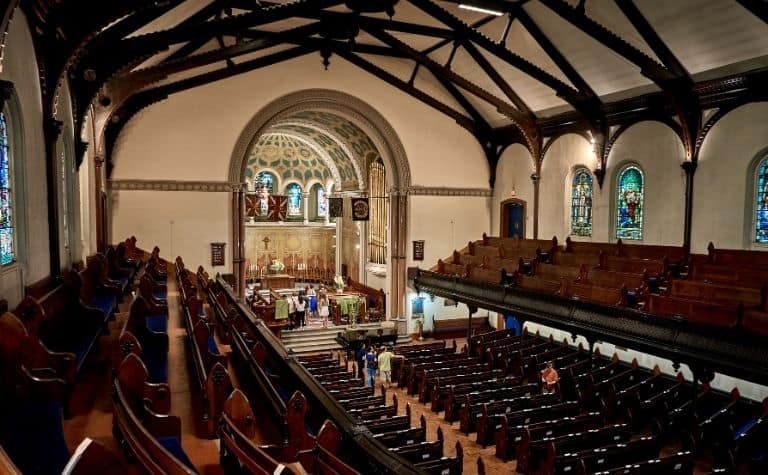The terms “denomination” and “sect” are commonly used in the context of belief systems comprising multiple internal groups with differing views on certain primary or secondary matters of the faith. Some people use the two terms interchangeably, yet others differentiate between them.
Generally, the terms “denomination” and “sect” both refer to a group within a religion that shares some beliefs with the wider tradition yet have unique convictions that lead them to practice independently of others. In some contexts, “denomination” is the accepted term, while “sect” is considered derogatory.
What are examples of denominations and sects in Protestantism, Roman Catholicism, and Eastern Orthodoxy? Why are there so many “denominations” in Protestant Christianity? What are the ten largest denominations in America? Keep reading to learn more.

Denominations and Sects in Christianity
To know the precise meaning of the terms “denomination” and “sect,” the best approach is to identify a speaker or author’s intent when using them. (Also see The Largest Christian Denominations: The Top 100)
Older resources may use the terms in one way, while modern sources use them in another way. In some sources, the terms have a neutral connotation, yet in others, they may have a positive or negative one.
| Denomination | Sect | |
|---|---|---|
| Dictionary definition | “a religious organization whose congregations are united in their adherence to its beliefs and practices” (Merriam-Webster) [1] | “a dissenting or schismatic religious body; especially: one regarded as extreme or heretical” (Merriam-Webster) |
| Orthodoxy | Denominations are usually considered orthodox, which means that they adhere to the primary doctrines of the faith. | Historically, outsiders have considered sects unorthodox, but today, context and user intent determine their meaning. |
| Examples in Protestant Christianity | Baptist, Lutheran, Presbyterian, Methodist, Episcopalian, Assemblies of God | In conventional use, Protestant denominations aren’t considered “sects.” |
| Examples in Roman Catholicism | Coptic Catholic Church, Latin Church, Armenian Catholic Church | Community of the Lady of All Nations, Palmarian Catholic Church, Philippine Independent Church |
| Examples in Eastern Orthodoxy | Russian Orthodox Church, Church of Greece, Romanian Orthodox Church | Orthodox Church of France, Evangelical Orthodox Church, American Orthodox Catholic Church |
Geography often forms denominational organizations in Roman Catholicism and Eastern Orthodoxy. These denominations are in full communion with the leadership and other churches in the tradition.
“Sects” within these traditions may reflect the geographical organization, but they aren’t in full communion with other churches.
Each sect has different reasons for not being in full communion with others. However, most splintered off due to doctrinal disagreements or as a result of tension and dissatisfaction with leaders in the tradition. (Also see Non-Denominational vs. Catholic: What’s the Difference?)
Denominations in the Protestant tradition aren’t referred to as being in “full communion” with leaders and other churches in the tradition because there is no centralized authority like in Roman Catholicism and Eastern Orthodoxy.
Though Protestant denominations are independent of each other in relation to government and finances, many have a good relationship with other like-minded denominations and work together for ministerial purposes. (Also see Do All Denominations Observe Lent?)

Denominations in Protestant Christianity
There are several denominations in the Protestant tradition. Protestant Christianity, more so than Roman Catholicism and Eastern Orthodoxy, is known for how many denominations it has.
Some estimate that the tradition includes over 300 denominations. [2] Why are there so many? There are two main reasons:
- Protestantism has no central authority. There is no single leader in the Protestant tradition that has the power to prohibit new denominations or churches from starting. In Roman Catholicism and Eastern Orthodoxy, the formation of new denominations (most are geographically organized) and churches are rooted in the vision of the tradition’s central leadership.
- Protestantism flourishes in free countries. Many Protestant denominations started in Europe, and some experienced tension with civil authorities and fought for the right to exist in their early years. However, in recent centuries denominations have experienced fewer restrictions, especially in America, where religious freedom is a core value.
Where do all the Protestant denominations come from? Most trace their roots to the 16th-century Reformation in Europe when men like Martin Luther of Germany (1483-1546), Ulrich Zwingli of Switzerland (1484-1531), and John Calvin of France (1509-1564) charged the Roman Catholic church with a variety of abuses.
Luther, for example, didn’t want to start a new denomination but sought to reform the Catholic church, eradicating its negative and unbiblical practices.
When Catholic leadership resisted Luther’s efforts, a new branch of the Christian faith, called “Lutheranism,” took root. (Also see Is Catholicism a Religion or a Denomination?)
Do all Protestant denominations agree with each other on doctrine? What makes a group a “denomination’ rather than a different “religion” is that they have the same core beliefs.
For example, Baptists, Lutherans, Methodists, Presbyterians, Episcopalians, and Assemblies of God all believe in the Trinity and the inspiration of Scripture.
Yet they don’t have agreement on secondary matters like church governance, the Lord’s Supper, baptism, speaking in tongues, and the end times.
Did all Protestant denominations start in the 16th century? No. Some denominations that exist today splintered off those that started in the 16th century.
For example, the Anglican denomination in England started in the 16th century. The Methodist denomination splintered off the Anglican church in the 18th century when the leadership rejected the reforms of the founder, John Wesley (1703-1791).
Are there multiple denominations within a single tradition? Yes. Some traditions contain multiple denominations. These branches share some convictions with their tradition but have disagreements and unique beliefs compared to others. Examples include,
- In the Baptist tradition: Southern Baptists, American Baptists, Conservative Baptists
- In the Presbyterian tradition: Presbyterian Church USA, Presbyterian Church in America, Evangelical Covenant Order of Presbyterians
- In the Methodist tradition: United Methodist Church, African Methodist Episcopal Church, Wesleyan Church
- In the Lutheran tradition: Lutheran Church—Missouri Synod, Wisconsin Evangelical Lutheran Synod, Evangelical Lutheran Church in America
Also, see What Are the Different Catholic Denominations?

The Largest Denominations in America
The chart below is organized according to specific denominations, not its wider tradition.
| Rank | Protestant Denomination | Population/ Founding/ Churches |
|---|---|---|
| 1 | Southern Baptist Convention | 16 million 1845 45,800 |
| 2 | United Methodist Church | 7.6 million 1968 33,600 |
| 3 | National Baptist Convention, USA, Inc. | 5 million 1895 10,000 |
| 4 | Evangelical Lutheran Church in America | 4.1 million 1988 9,800 |
| 5 | Assemblies of God | 3.1 million 1914 12,900 |
| 6 | National Missionary Baptist Convention of America | 2.5 million 1988 1,300 |
| 7 | African Methodist Episcopal Church | 2.5 million 1814 7,000 |
| 8 | Baptist General Conference of Texas | 2.4 million 1848 5,300 |
| 9 | Lutheran Church-Missouri Synod | 2.2 million 1847 6,100 |
| 10 | Episcopal Church | 2 million 1789 6,800 |
Also, see Do All Christian Denominations Use the Same Bible Translation?
References:
[1] Source
[2] Source
[3] Source
Related Questions
Wondering What Denominations Are Calvinist? Here’s the Answer
The teachings of French pastor and theologian John Calvin (1509-1564) have been a significant part of the Protestant branch of the Christian faith for over 500 years. At the beginning of the 21st...
Arminianism, which is often contrasted with Calvinism, has been an influential theological belief system in Protestant Christianity for 500 years, though some aspects of it are much older. Just like...
